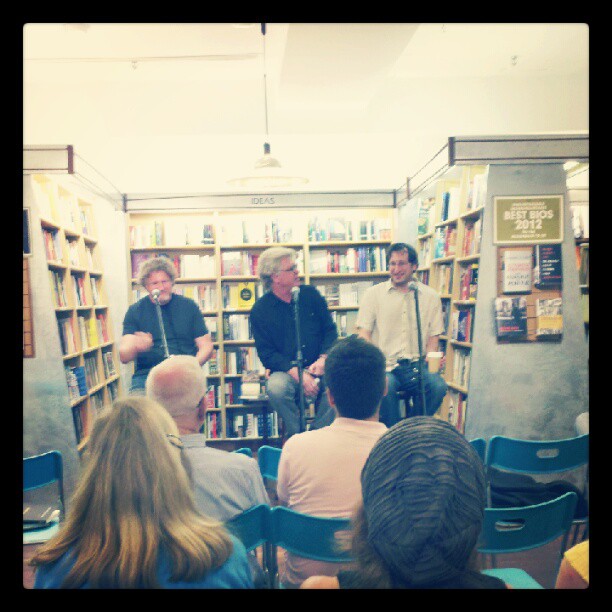
Last Thursday night, I ventured out to McNally Jackson for an event titled “The Comedy of Noir,” featuring readings and discussion from the writers Brian Evenson, Tim Horvath, and Bradford Morrow. All of them have been responsible for work I admire; I’d recently reviewed books from Horvath and Evenson. I’ve known Morrow more via his editorial duties at the excellent journal Conjunctions, though I did end up picking up his novel The Diviner’s Tale once the reading had ended.
The night opened with readings: Evenson led off with a short passage from his novel Immobility, setting up that novel’s themes of lost identities and moral ambiguity; he then read the title story from the collection Windeye, which touched on childhood games, sinister houses, and the horrors of memory. Evenson’s measured tones downplayed the story’s more wrenching elements in favor of its more ambiguous ones; and yet, the final lines (“dead, or not alive”) haunted just as much. Horvath foll0wed, reading a long excerpt from his story “The Conversations,” in which a series of rote conversations turn deadly to the speakers and many in their proximity. Evenson returned to the stage to join Morrow in reading a story titled “(Mis)laid,” an account of a man who loses his mind, his mistress, and her husband. Throughout, two voices shed light on different aspects of the narrative, and the pair of authors had complimentary approaches: Morrow’s more authoritative tones balanced by Evenson’s more matter-of-fact delivery.
When the three authors all took to the stage for a question-and-answer session, the night’s true highlight began. One question, addressed to Morrow, invoked his story’s dueling narrators. Morrow responded by referencing William T. Vollmann’s You Bright and Risen Angels, though he stressed that in the case of his story, the narrators were more “two parts of the same brain narrating the same story.”
The title of the evening prompted a number of questions, including one about the difference between comic noir and black comedy. Horvath began with a story of wildly misunderstanding the notion of “black comedy” in his youth as a result of an incorrect reading of the jacket of T.C. Boyle’s Descent of Man. Morrow referenced Matthew Gregory Lewis’s 1796 Gothic novel The Monk, and cited a Stephen King essay on the novel in question as arguing that Lewis’s novel has endured because of its use of humor. And Evenson noted that both noir and the concept of black comedy have origins in France.
Another member of the audience asked the writers if they were ever surprised at what crowds laugh at. Evenson mentioned that context and location can be significant; he recalled reading a story that he considered funny in a church basement; the space made the story being told less humorous. A followup question inquired as to whether the authors knew something was funny when they wrote it; Horvath compared that to “trying to tickle yourself.” Evenson cited the importance of funniness being organic to the story, and Morrow commented that his “writing gets funny when I’m being really, really evil.” If “(Mis)laid,” which involves kidnapping, adultery, and insanity, is any indication, Morrow can be at his funniest and wittiest when he’s doing awful things to his characters — and that divide, between horrific events and moments of unlikely comedy, suggested why the evening’s topic is such a resonant one.
Follow Vol. 1 Brooklyn on Twitter, Facebook, Google + and our Tumblr.
